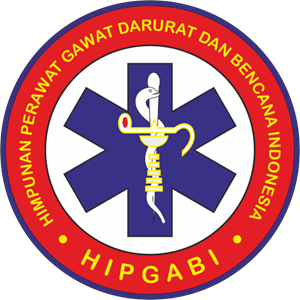LITERATURE REVIEW : PERCUTANEUS CORONARY INTERVENTION SEBAGAI TINDAKAN EMERGENSI PADA KASUS INFARK MIOKARD AKUT AKIBAT TRAUMA TUMPUL THORAX
Downloads
Latar belakang: Infark miokard akut (IMA) penyebab non aterosklerotik pada dewasa muda disebabkan oleh trauma tumpul thorak merupakan kasus yang langka, tetapi berpotensi mengancam nyawa yang harus ditangani segera pada pasien yang datang ke IGD. Percutaneus Coronary Intervention (PCI) adalah standar emas untuk diagnosis dan manajemen. Karena prognosis pasien ini terkait erat dengan diagnosis dan penatalaksanaan dini, sangat penting untuk menjaga indeks kecurigaan yang tinggi untuk Acute Coronary Syndrome (ACS) pada pasien dengan trauma tumpul thorax dan nyeri dada. Tujuan: penelitian ini bertujuan untuk menyajikan tindakan PCI pada pasien IMA disebabkan oleh trauma tumpul thorax dan untuk meninjau beberapa litelatur mengenai topik ini. Metode: penelitian ini merupakan bentuk literature review terhadap artikel dengan tema Percutaneus Coronary Intervention pada pasien infark miokard akut penyebab trauma tumpul thorax. Artikel pada penelitian ini berasal dari database elektronik Google Scholar, PubMed, Proquest, Scopus dan Science Direct dimulai tahun 2005 sampai dengan 2020. Hasil: hasil penelusuran menggunakan kata kunci Percutaneus Coronary Intervention, acute myocardial infarction, blunt chest trauma diperoleh 56 artikel. 15 artikel yang memenuhi kriteria inklusi kemudian dilakukan review terhadap full text nya. Kesimpulan: Tindakan emergensi Percutaneus Coronary Intervention efektif dilakukan dan merupakan terapi yang aman untuk kasus Infark Miokard Akut akibat trauma tumpul Thorax. Tindakan emergensi Percutaneus Coronary Intervention menjadi pilihan terbaik untuk pasien tanpa disertai dengan perdarahan pada organ lain.
Abdolrahimi SA, Sanati HR, Ansari-Ramandi MM, Heris SO, Maadani, M. (2016). Acute myocardial infarction following blunt chest trauma and coronary artery dissection. J Clin Diagnostic Res, 10(2),14-15.
ACLS. (2018). Acute Coronary Syndrome Algorithm. https://www.acls.net/images/algo-acs.pdf
Al-Aqeedi, R. F., Ali, W. M., Al-Ani, F., Abdulrahman, Y. S., & Alnabti, A. (2011). A blunt chest trauma causing left anterior descending artery dissection and acute myocardial infarction treated by deferred angioplasty. Qatar: Departements of Cardiology and Cardiovascular Surgeryo.
Ander, R., Luis, A., Vitoria, M., Gizem, K., & Manel, S. (2012). Right Coronary Artery Dissection following Blunt Chest Trauma. The European Society of Cardiology: Acute Cardiovascular Care, 1(1),50-51
Asih, N. G. Y., & Effendy, C. (2004). Keperawatan Medikal Bedah: klien dengan gangguan sistem pernafasan. Jakarta: EGC.
Bernardin B. & Torquet J.M. (2012). Initial Management and Resuscitation of Severe Chest Trauma. Emerg Med Clin North Am, 30(2),377-400.
Capodanno D, Alfonso F, Levine GN, Valgimigli M, Angiolillo DJ. (2018). ACC/AHA Versus ESC Guidelines on Dual Antiplatelet Therapy: JACC Guideline Comparison. J Am Coll Cardiol. Dec 11;72(23 Pt A):2915-2931.
Colombo, F., Zuffi, A., & Lupi, A. (2014). Left main dissection complicating blunt chest trauma: case report and review of literatur. Cardiovascular Revascularization Medicine.
Emet, M., Akoz, A., Aslan, S., Saritas, A., Cakir, Z., & Acemoglu, H. (2010). Assessment of cardiac injury in patient with blunt chest trauma. Eur J. Trauma Surg, 36, 441-447.
Fu, Z. L., & Yao, H. C. (2013). Percutaneus coronary intervention for acute myocardial infarction following blunt chest trauma. International Journal Of Cardiology, 168(3), 2983-2984.
Haryanto, Budi. (2018). Percutaneous Coronary Intervention (PCI). Jakarta : Pusat Jantung Nasional.https://www.pjnhk.go.id/artikel/percutaneous-coronary-intervention-pci
Henry, T., Atkins, J., & Cunningham, M. (2006). ST-segment elevation myocardial infarction: recommendations on triage of patients to heart attack centers: is it time for a national policy for the treatment of ST-segment elevation myocardial infarction? J. Am Coll Cardiol, 47(7), 1339-1345.
Jonathan, H., Chung, Christian, C. W., Tan-Lucien, M. H., Jacoba, K., Kathleen, B., et al. (2013). Blunt chest trauma. American College of Radiology.
Lin, Y., & Yu, C. (2011). Acute miocardial infarction caused by coronary artery dissection after a blunt chest trauma. Intern Med 50(18), 1969-1971.
Lobay, K., & Macgougan, C. (2012). Traumatic coronary artery dissection: a case report and literatur review. J. Emerg Med, 43(4), 239-243.
Lolay GA, Abdel-Latif AK. (2016). Trauma induced myocardial infarction. Int J Cardiol. 203,19- 21.
Murphy, S., Xu, J., & Kochanek, K. (2010). Deaths: preliminary data for 2010. National Center or Health Statistics, 60(4).
Gurfinkel, E., & Lernoud, V. (2006). Prevention of miocardial infarction. Curr Opin Cardiol, 21(5), 503-509.
Perez, O., Nair, R.M., Kewan, T., & Al-Jaghbeer, M. (2020). A Rare Case of ST-Elevation Myocardial Infarction After Blunt Chest Trauma. Cureus. 12(4), 1-9.
Rahul, R. , Dilip, M., & Pankaj, J. (2013) Acute Myocardial Infarction Following Blunt Chest With Intracranial Bleed: A Rare Case Report. Indian Heart Journal, 65, 311-314.
Tobin, J. M., & Varon, A. J. (2012). Update in trauma anesthesiology: perioperative resuscitation management. Anesth Analg, 115(6), 1326-1333.
Tsai, T., Yang, S., Tsao, T., Huang, K., & Cheng, S. (2005). Delayed diagnosis of post-traumatic acute myocardial infarction complicated by congestive heart failure. J. Emerg Med, 29(4), 429-431.
Waksman R, Di Mario C, Torguson R, Ali ZA, Singh V, Skinner WH, Artis AK, Cate TT, Powers E, Kim C, Regar E, Wong SC, Lewis S, Wykrzykowska J, Dube S, Kazziha S. (2019). Identification of patients and plaques vulnerable to future coronary events with near-infrared spectroscopy intravascular ultrasound imaging: a prospective, cohort study. Lancet.Nov 02;394(10209):1629-1637.
Copyright (c) 2020 Ninik Ambar Sari, Nisha Dharmayanti Rianto

This work is licensed under a Creative Commons Attribution 4.0 International License.
1. The journal allows the author to hold the copyright of the article without restrictions.
2. The journal allows the author(s) to retain publishing rights without restrictions.
3. The legal formal aspect of journal publication accessibility refers to Creative Commons Attribution (CC BY).

















